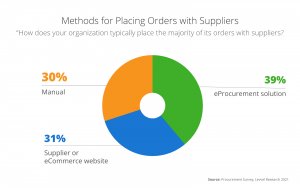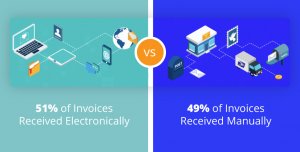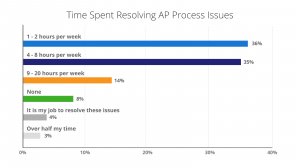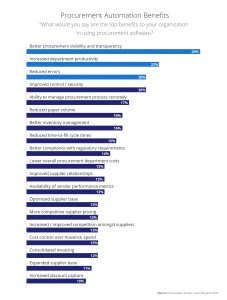In essence, procure-to-pay is a simple process. A request is created to purchase goods and then sent to the appropriate manager for approval. From here, an order is placed, the goods are delivered and the accounts payable team receives an invoice and pays it.
However, the majority of organizations struggle with the process. The process is made up of a number of smaller components such as supplier management, purchase requisitioning, invoice capture, and invoice matching, all of which present their own difficulties.
Source to pay automation streamlines the process of buying and selling. This reduces inefficiencies and costs while freeing up the time of employees to focus on more value-added tasks. However, the majority of organizations haven’t implemented any automation technology. A report by Levvel Research found that only 39% of organizations use an eProcurement solution, and 30% place orders manually.
In the next 12 months, companies plan to replace existing procurement software due to lack of supplier management and support capabilities, poor basic functionality, and weak security.

With 19% of companies complaining about outdated and inadequate technology, it’s clear that organizations require modern procure-to-pay solutions. But what if you’re struggling to get executive buy-in?
When you’re building the business case for automating your procure-to-pay business process, use these ten points to demonstrate return on investment (ROI) and win management support.
1. Controlling Non-Trade Spend
Non-trade spend refers to purchasing goods and services that will not be re-sold. Products and services such as stationery, electricity bills, and cleaning services all fall into this bracket. In many organizations, these products or services are paid for with a company credit card or petty cash. This can lead to the organization missing out on bulk discounts, maverick buying, and potentially overpaying.
We have found that when an organization adds a PO process to non-trade spend, they will typically spend 1-3% less. For example, an organization with a total spend of half a billion and a non-trade spend of $100 million (typically 20% of total spend) could save $3 million by controlling their non-trade spend process. With the right technology, companies can extend P2P and cover source to pay automation. End-to-end source-to-pay technology results not only in cost savings but also in stronger processes and improved regulatory compliance.
2. Manual Processing of Mail
The traditional manual process for handling paper-based mail can be very time-consuming and in turn, financially costly. A paper invoice will go through multiple touch points before it is fully-processed including perhaps the receptionist, an accounts payable clerk, and at least one approver. The same applies to invoices received via email.
Electronic invoicing drastically reduces processing times. While the majority of AP departments now receive electronic invoices, 49% still process manual invoices. E-invoicing minimizes paper-based processes, reducing cost per invoice processed by as much as 80%.

3. ERP Data Entry
Once a supplier invoice has been received, routed to the appropriate approvers, and approved, the data needs to be entered into the ERP finance system. In a traditional manual system, an accounts payable clerk will physically key information from an invoice into a software system. This manual process is very time-consuming and can often lead to data inaccuracy and data duplication.
Technologies such as Optical Character Recognition (OCR) automatically extract data and save it in a digital and searchable format. Automating data entry eliminates human errors while also saving enormous amounts of employee time. This allows accounts payable staff to reallocate their time.
The cost to process a single invoice is $10.89 while the IOFM claim the cost of manual processing can be anything up to $21. However, best-in-class companies leveraging ePayables technology and focusing on core processes reduce invoice processing costs by as much as 80%.
Based on the lower estimate of $10.89, if an organization processes 10,000 invoices per month, that amounts to savings of over $1 million per year.
4. Optimize Employee Time
Procure-to-pay automation accelerates the time taken to complete manual and time-consuming tasks. Jobs such as invoice matching can be automated, allowing organizations to reallocate staff members’ time to work on something more strategic. Many finance and accounts payable professionals spend several hours each week resolving issues within manual procure-to-pay processes. The graph below demonstrates how long staff spend each week resolving AP process issues.

5. Improved Invoice Approval Times
Invoice approval can be a bottleneck in the procure-to-pay process in many organizations. Approvers often allow invoices to ‘sit’ on their desk for days and in some cases weeks. It can take time for the invoice to get fully approved as it will have to be physically brought to and signed off manually by a number of different people.
With automation, invoices and requisitions are automatically routed to the appropriate approver with a couple of clicks on a platform or even through email. Based on our experience, this generally saves 75% of the time previously spent on approving invoices. For example, if an approver spends one hour a week approving invoices, automation would reduce this time to only 15 minutes a week.
For example, Grafton Group plc’s invoice approval process, which was typically more than 40 days, now only takes 10 days due to automation. Considering that this organization generates nearly $3 billion in revenue, you can appreciate the significance of the savings.
6. Dispute/Query Management
Manual procure-to-pay processes lead to invoice errors, duplicate invoices, late payments, and unhappy suppliers. Aside from the obvious implications such as paying the same invoice twice, dealing with these issues can be very time-consuming. The time that staff spend on ‘damage control’ is costing organizations thousands of dollars each year. The table below outlines annual labor costs for dispute management within organizations.

Source – SoftCo Estimates
7. Early Payment Discounts / Late Payment Penalties
Suppliers often offer discounts for buyers who pay their invoice early. Due to an organization’s lack of visibility into invoice lifecycles, these discounts are often missed. 23% of organizations consider capturing early payment discounts as part of the primary management goals.
However, one-half of organizations only capture discounts sometimes, and 16% never do. Organizations that use procure-to-pay software to automate and speed up their invoice lifecycle are saving around 20%. Depending on an organization’s invoice volume and size, the financial savings could be millions of dollars.

8. Temporary Staff Reductions
Many organizations opt to outsource their accounts payable process. Procure to pay outsourcing often improves operations without requiring in-house investment. Although these organizations understand that there is a better way to pay for goods and services, they aren’t completely fixing the issue and outsourcing can be expensive.
When accounts payable is outsourced, human error tends to increase, leading to duplicate invoicing, paying an incorrect amount, or paying the invoice to an incorrect supplier.
9. KPIs
Finance leaders often have very little visibility into the finance process. Many have no idea where a particular invoice is at any given time, or if a PO was fulfilled which often leads to organizations reacting to problems rather than being proactive. Receiving too much data makes tracking even more difficult, which is why companies require a report on KPIs.
Companies rely on key performance indicators or KPIs to measure progress towards a goal. Procurement KPIs focus on cost savings, product quality, and operational efficiency.
A study by PWC found that 56% of the respondents still use spreadsheets and manual processes to track KPIs. This has caused a global trend to move towards automation, even for non-financial KPIs. Technology offers the capability to identify KPIs and continuously monitor them for change, so you don’t have to manually track KPIs for reporting.
Through automating the procure-to-pay process, finance leaders gain full visibility into the entire process, even offering suppliers the ability to log in and view progress on payment of their own invoices.
10. Reporting
Technology is especially beneficial for finance leaders who create reports for financial month, quarter, or year-end.
A Sage survey found that it takes more than a week for 60% of organizations to close their books. A close process highly reliant on spreadsheets takes 36% longer, and manual imports and exports lengthened closing cycles by 25%. Companies who invested in technology closed 25% faster compared to those who added headcount to assist with the financial close.
Addressing the need for accurate and accessible information in short notice requires the right technology, especially with the shift to a remote or semi-remote workplace. Cloud-based procurement-to-pay solutions not only shortens the accounting closing cycle through integration, it also supports a remote accounting close.
Conclusion
When presenting a business case for procure-to-pay automation, keep in mind the above benefits specific to your situation. The procure-to-pay ecosystem is much larger than only these 10 stages, and senior management need to understand the hard and soft savings the organization can capture by embracing. Building a solid business case for source to pay automation helps to achieve growth and drive savings.



